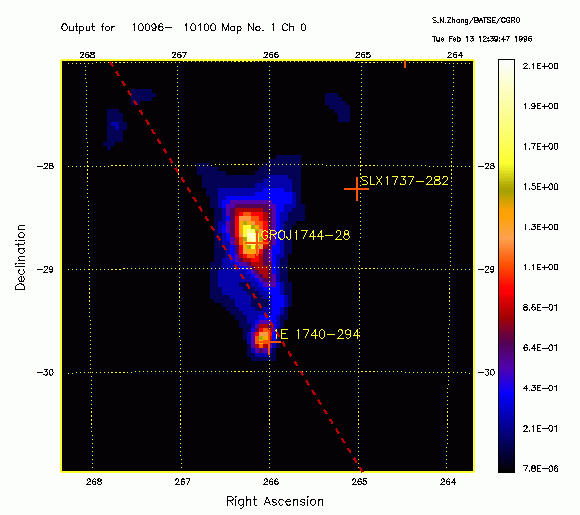The Bursting Pulsar GR0 J1744-28


BATSE images of GRO J1744-28 bursting (left), and quiet (right).
The Bursting Pulsar was discovered by the BATSE experiment on Dec 2 1995, when it was brightening at a rate of 18 bursts per hour in the 20-50 keV range. Each burst typically lasted 8-30 seconds. The burst rate has since decreased to about 1 per hour. A related persistent source was discovered Jan 1 1996. The persistent source, designated GRO J1744-28, was for a period the brightest X-ray source in the sky, a few times brighter than the Crab pulsar.
Pulsar timing reveals that GRO J1744-28 is a binary system consisting of a neutron star, approximately 1.4 solar mass, and a second star, of about 0.07-0.14 solar mass. The two stars orbit a common center of mass every 11.8 days.
X-ray observations with the ROSAT/HRI satellite localized the X-ray source to within 8 arc-seconds, (1 arc-sec = 1/3600 degrees). This X-ray location led to the discovery of an infrared counterpart, whose brightness dimmed by over 1 magnitude between Feb 8 and Mar 28. The decrease in infrared brightness offers confirmation that GRO J1744-28 is a low-mass x-ray binary.
The end of the first outburst came May 3 1996, and the persistent flux in the 20-100 keV became undetectable to BATSE. X-ray bursts were again detected on June 1 1996 by RXTE/PCA, with burst rates of 1 every 45-60 min. By mid June, the burst rate increased to 1 every 1-3 minutes. At the end of June the burst rate had again dropped below 1 burst per hour.
If you have a question about CGRO, please contact us via the Feedback form.

